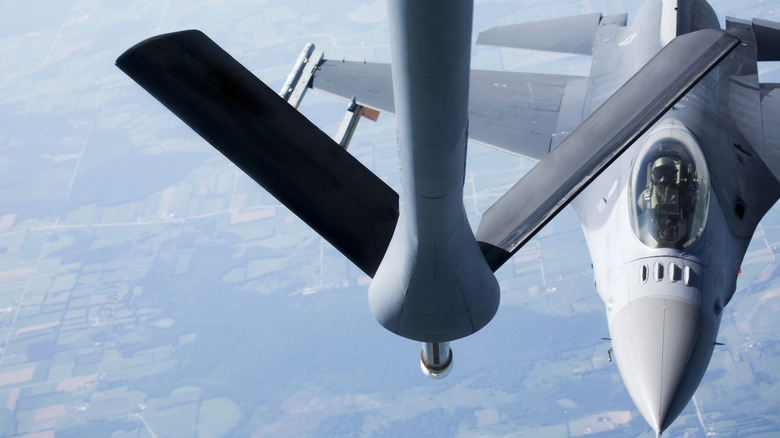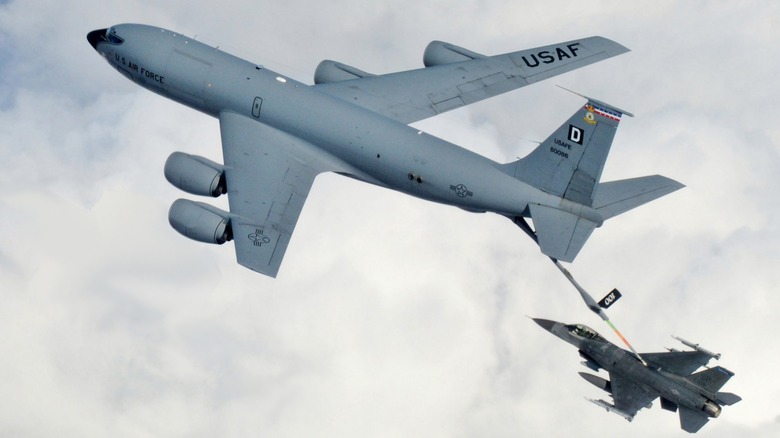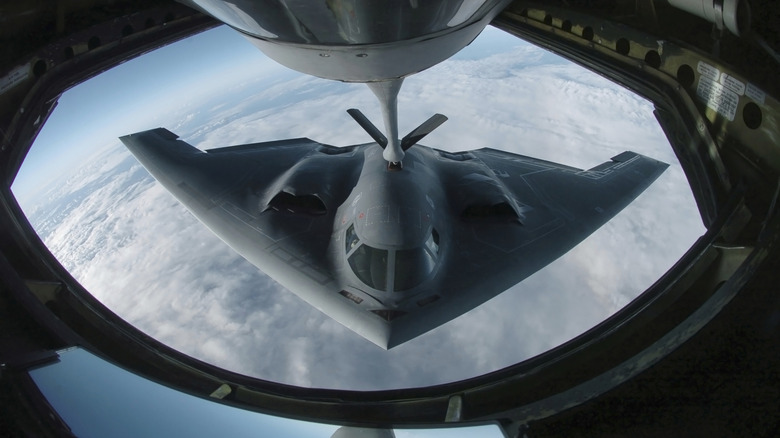How Do Fighter Jets And Other Aircraft Refuel In The Air?
Aircraft that fly via propellers often require less fuel than fighter jets, which is one of the reasons the U.S. military still uses propeller-driven aircraft. Still, you can't discard jet engines, which have enabled pilots to push their aircraft to incredible speeds, and as technology moves forward, they keep getting faster and faster. Jets are far less efficient at burning fuel than propeller-driven planes, so they use up their fuel reserves relatively quickly. This is one of the reasons some fighter jets carry extra fuel tanks on their hardpoints.
While those tanks are great at extending an aircraft's range, they will only take the plane so far. For a fighter jet to cover the distance when it really has to travel distance, it can refuel. While it's certainly possible that a pilot could land at a friendly airbase or airport and top off their fuel tanks, there's a better option: aerial refueling. The U.S. military operates a fleet of airborne tankers, the Boeing KC-135 Stratotankers, that can deliver thousands of gallons of fuel to all kinds of aircraft, including Air Force One, which can be refueled in the air.
While the option is available, and it's used often, refueling while in mid-flight isn't necessarily easy. The people involved need to train to be able to do it, and while that includes the fighter pilot, it also means everyone onboard the tanker needs to be up to date on their training as well. There are two processes to aerial refueling, and it's some impressive engineering that it's even possible for fast-moving aerial objects to come into contact with one another and exchange highly volatile fuel — here's how both methods, "probe-and-drogue" and the flying boom, work.
How aerial refueling works
A fighter jet must meet the tanker in the air to refuel, and they must be within 100 feet of each other to initiate the process. The pilots of both aircraft must maintain this distance and adjust as needed to accommodate for turbulence and other disruptions. Once they are close enough, there are two different ways a fighter can refuel. The probe-and-drogue involves a long hose with a funnel-shaped device at the end called a drogue. This is plugged into a probe on the receiver.
Not only do the planes have to be close, but maintaining a specific airspeed is necessary for the transfer to work. If they are too slow, the probe won't latch for the transfer, and moving too fast can break the equipment. The second method, the flying boom, uses a rigid tube called a boom that connects the two aircraft. This is directed into a small opening in the fighter, and then fuel passes between the two aircraft. This method is ideal for the Air Force because it's considerably faster.
The probe-and-drogue method transfers fuel at a rate of 2,000 pounds per minute — while the Flying Boom is three times faster at 6,000 pounds per minute. Safety features will sever the connection if sudden movements or changes in airspeed endanger the process and personnel involved. Refueling can take around ten minutes to complete, and once done, the fighter goes on its way with a full tank of fuel while the tanker moves on to refuel another plane or top off its own tanks on the ground.
What U.S. aircraft can refuel and what can refuel them?
Given the clear tactical and strategic benefits of aerial refueling, most U.S. military aircraft have the capability. Additionally, the KC-135 isn't the only tanker in town, as the KC-130 Hercules can also be used as a tanker, and the KC-46A Pegasus is the newest tanker set to replace the KC-135. More are in development, including a carrier-based refueling drone, the MQ-25 Stingray. It's also possible for some existing aircraft that aren't tankers to function as such.
The U.S. Marine Corps has been improving the V-22 Osprey into an aerial refueling platform. It's also possible to refuel some helicopters. Hot in-flight refueling (HIFR) can be accomplished via a hose and a low-hovering chopper. Similarly, Helicopter Air-to-Air Refueling (HAAR) is much like the standard fixed-wing process and can be accomplished via a probe-and-drogue, thanks to a chopper's extendable probe — the HH-60 Pave Hawk has this capability.
Most fighter jets can refuel in the air, including the F-15 Eagle, F-16 Fighting Falcon, F/A-18 Super Hornet, F-22 Raptor, F-35A Lightning II, and many others. Various bombers like the pictured B-2 Spirit can also refuel while in the air, which is good, seeing as strategic bombers often have to fly for extended distances, and unrefueled, they can fly for 5,965 miles. Making planes that can refuel in the air is standard practice for today's military, and it also gives a distinct advantage to American fighters over potential adversaries that lack the ability.


